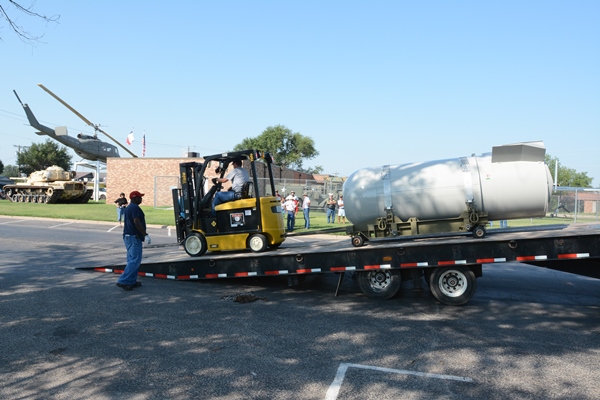Pantex Blog
Pantex Supports United Way

Clarence Rashada holds up a sign expressing Pantexan support during the United Way campaign kickoff event last week as Kendra Garcia, from left, Kathy Felder and Charles Thomas look on. The four are loaned executives from Pantex, sent to support the United Way campaign, which has a theme this year of “Make it Personal.”
Each year, Pantex employees pledge hundreds of thousands of dollars to United Way of Amarillo and Canyon, making the plant a top giver to the campaign.
Wild Pantex – Songbirds, Satellites, and the Tiniest of Technologies
Article by Jim Ray, Pantex Wildlife Biologist/Scientist
As mind-boggling as it may seem, as of this writing 13 adult songbirds are currently drifting southward, if not already soaring over the mighty Amazon River basin…with tiny GPS units strapped to their topsides. This is the first year that this technology has produced a unit small enough to be worn by such a small bird. An additional 12 birds sport a different kind of backpack, one that measures light-levels, only to be later converted by a computer program to a longitude and latitude, thus, like the GPS units, pinpoint locations of the birds as they make the roundtrip from a breeding site in Randall County to wintering areas in Brazil.
Although part of a larger partnership and research endeavor led by York University (Toronto, Canada), the University of Manitoba (Winnipeg, Canada), and the Purple Martin Conservation Association, the inclusion of Texas Panhandle birds in the range-wide study in 2013 and 2014 was made possible by Pantex – thanks to the commitment to the conservation of migratory birds displayed by the U. S. Department of Energy/National Nuclear Security Administration in cooperation with Consolidated Nuclear Security, LLC. An Executive Order and Memorandum of Understanding between the agencies and the U. S. Fish and Wildlife Service guides that conservation.
The subject bird is the Purple Martin (Progne subis), which is the largest swallow species in North America. The eastern subspecies, which is distributed east of the Rocky Mountains, nests almost exclusively in man-supplied bird housing. This and the fact that it is most apt to nest in such housing that is situated among human habitations, golf courses, and other such places, makes the bird a great subject for study. Much of what can be learned from the easily accessible Purple Martin, can tell us volumes about the migratory and wintering habits of other, much harder-to-study songbirds with similar life histories. Many of these are declining in population, as is the Purple Martin within some portions of its range of distribution.
2013
You may recall the news and social media reports on our deployment of geolocators that took place last year: See: Pantex Gets Hands on With Purple Martins, NNSA Blog, and Wildcat Bluff Blog. Those birds departed from the colony in early August to points unknown.
2014
In mid-February, individuals began to make their appearance again back at their colony site. Then, came a little bad luck. A family down the street with a large colony of Purple Martins moved away and took their martin housing with them. These birds, finding their nesting cavities missing, rapidly started filling in the available cavities at our study colony. This is normally a good problem to have!
However, we needed room for all of those returning geolocators! I ordered and put up more housing as fast as I could to try to make room for any geolocator-marked bird that had yet to secure a cavity or arrive from South America. I had new gourd bird houses hanging on the basketball goal, on the old swing set, and I erected 12 more on a fancy pole system out behind the house. These all filled up rapidly with pairs, but only eight geolocators were retrieved, which is a lower rate of return than what you would normally expect.
York University collaborators are currently analyzing our data, which I will share once the information gets published. However, I will say this. Preliminary data indicates that our birds and, to a lesser extent, those of a site at Corpus Christi –also on the western edge of the range—will be pointed out as being “different” in one aspect of their migration than those from all of the other study sites which are scattered from Alberta to Florida. In addition, there are a couple of other revelations that will be worth mentioning.
Oh, and next year the GPS backpacks which have a much higher accuracy, may be able to pinpoint the various trees or other structures that these birds are utilizing while away from our area. Stay tuned!
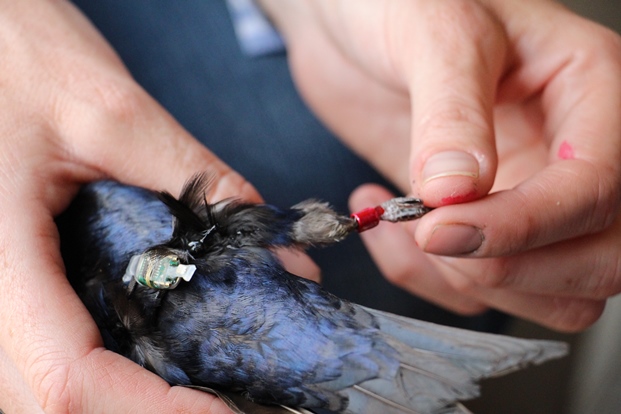
An adult male Purple Martin with a geolocator and band painted red to make it easier to be “picked out” among the other birds in the colony as being just released or needing recaptured.
Pantex Receives Seven NNSA Awards
Pantexans recognized for stockpile stewardship work
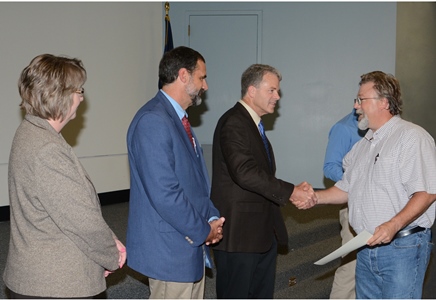
Pantexan Dave Thomas, from right, receives a Defense Programs Awards of Excellence from NNSA Assistant Deputy Administrator for Stockpile Management Steve Goodrum, while NNSA Production Office Manager Steve Erhart and Pantex Site Manager Michelle Reichert wait to congratulate him.
NNSA Assistant Deputy Administrator for Stockpile Management Steve Goodrum recently presented Defense Programs Awards of Excellence (DPAE) to 175 Pantexans who excelled at Stockpile Stewardship work during 2013.
The seven awards were presented to teams involved in a variety of efforts which include nuclear weapons work, environmental remediation, high explosives testing and production planning.
The DPAE program was established in 1982 to recognize individuals or teams for significant achievements in quality, productivity, cost savings, safety or creativity of work performed in support of the Stockpile Stewardship Program.
“It is a great honor for so many Pantexans to be recognized for their outstanding work in support of Stockpile Stewardship,” said Pantex Site Manager Michelle Reichert. “The number of awards and the diversity of work involved are truly indicative of the dedication and innovation of the entire team at Pantex.”
DP Awards were presented to Pantexans involved in the following efforts:
- A team of 28 Pantexans was able to resolve an issue related to the W76-1 Life Extension Program (LEP).
- A team of 51 people at Pantex reconfigured the plant’s Laser Gas Sampling System to perform work on the B83, completing 124 percent of the planned workload in FY13.
- A trio of environmental experts at Pantex performed excellent work to complete the five-year review of the site’s legacy contamination cleanup remedies under the auspices of the Comprehensive Environmental Response, Compensation and Liability Act.
- A team of 10 Pantexans was able to redesign and rebuild a device used to test high explosive response to electric shock.
- A team of 20 Pantex workers provided excellent support to the Warhead Measurement Campaign (WMC), which is a program designed to obtain a standardized set of signature data from the enduring stockpile and historical U.S. weapons.
- The NNSA Integrated Production Planning and Execution System (IPRO) Implementation Project Team achieved a major milestone with the deployment of IPRO at Pantex.
- Another team of 40 Pantexans is being honored for outstanding support of the new IPRO system, utilizing existing technology to effectively answer end-user questions and share knowledge with other sites.
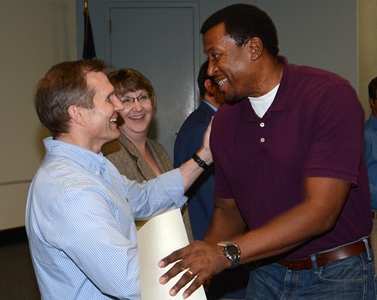
Consolidated Nuclear Security CEO Jim Haynes, left, congratulates Lennon Mings, right, for winning a DPAE as Pantex Site Manager Michelle Reichert looks on.
Pantex Conducts Emergency Exercise
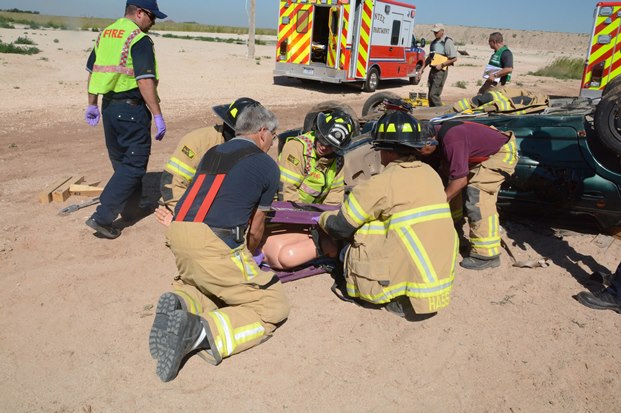
Pantex Fire Department emergency response personnel work to extract a training mannequin from beneath an overturned car at the plant’s emergency exercise Wednesday. The exercise, which involved numerous offsite participants from local and state agencies, centered on a simulated tornado that struck the plant, leading to the overturned vehicle.
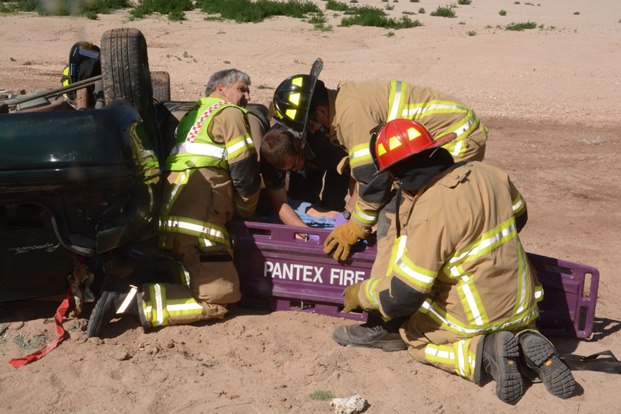
Last of Big Dogs Gets New Home
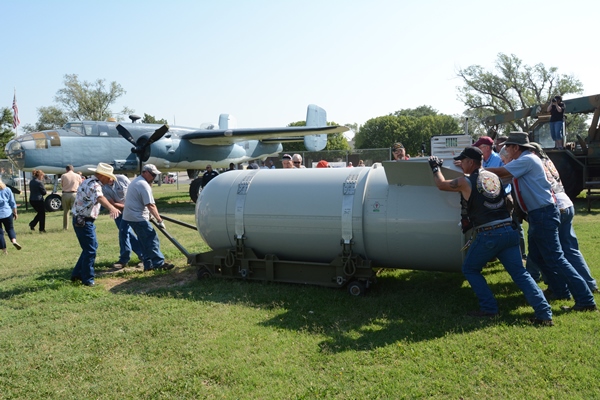
“The Last of the Big Dogs” has a new home after Pantex workers Wednesday delivered one of the few remaining B53 nuclear weapons cases to the Freedom Museum USA in Pampa, Texas.
The final B53, which received its “Big Dog” nickname from dismantlement workers due to its massive size, was dismantled at Pantex on October 25, 2011 in an historic ceremony. The B53 was a Cold War icon, and was the oldest, the largest and the most destructive nuclear weapon in the U.S. arsenal at the time it was retired.
Monica Graham, Pantex historian, was looking for a way to preserve the legacy of the B53 and honor the workers who built, maintained and dismantled it. The Freedom Museum, which is located about 45 minutes from Pantex, volunteered to take the weapon on loan to add to its large collection of historical military artifacts.
“This was an important effort to publicly display this iconic weapon that served in secret for decades, helping to ensure the safety of America,” Graham said.
The B53 was first put into service in 1962, a year when Cold War tensions were at their highest during the Cuban Missile Crisis. It served a critical role in the nation’s nuclear deterrent through the end of the Cold War, retiring from the active stockpile in 1997.
The B53 weighed around 10,000 pounds and was about the size of a minivan. Many B53s were dismantled in the 1980s, but a significant number remained in the U.S. arsenal until they were retired in 1997.
The B53 which was delivered this week consisted only of the outer casing of the weapon and is empty on the inside. It is one of only three such museum artifacts in the country built from a stockpile weapon. The others were assembled from training units or spare parts.
